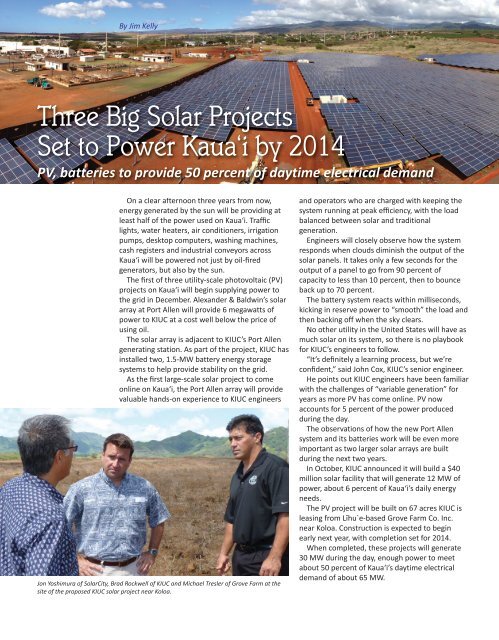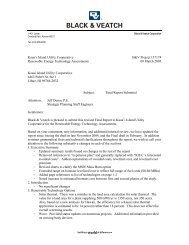Port Allen Solar Array Ready to Shine - Kauai Island Utility ...
Port Allen Solar Array Ready to Shine - Kauai Island Utility ...
Port Allen Solar Array Ready to Shine - Kauai Island Utility ...
Create successful ePaper yourself
Turn your PDF publications into a flip-book with our unique Google optimized e-Paper software.
By Jim Kelly<br />
Three Big <strong>Solar</strong> Projects<br />
Set <strong>to</strong> Power Kaua‘i by 2014<br />
PV, batteries <strong>to</strong> provide 50 percent of daytime electrical demand<br />
On a clear afternoon three years from now,<br />
energy generated by the sun will be providing at<br />
least half of the power used on Kauaʻi. Traffic<br />
lights, water heaters, air conditioners, irrigation<br />
pumps, desk<strong>to</strong>p computers, washing machines,<br />
cash registers and industrial conveyors across<br />
Kauaʻi will be powered not just by oilfired<br />
genera<strong>to</strong>rs, but also by the sun.<br />
The first of three utilityscale pho<strong>to</strong>voltaic (PV)<br />
projects on Kauaʻi will begin supplying power <strong>to</strong><br />
the grid in December. Alexander & Baldwin’s solar<br />
array at <strong>Port</strong> <strong>Allen</strong> will provide 6 megawatts of<br />
power <strong>to</strong> KIUC at a cost well below the price of<br />
using oil.<br />
The solar array is adjacent <strong>to</strong> KIUC’s <strong>Port</strong> <strong>Allen</strong><br />
generating station. As part of the project, KIUC has<br />
installed two, 1.5MW battery energy s<strong>to</strong>rage<br />
systems <strong>to</strong> help provide stability on the grid.<br />
As the first largescale solar project <strong>to</strong> come<br />
online on Kauaʻi, the <strong>Port</strong> <strong>Allen</strong> array will provide<br />
valuable handson experience <strong>to</strong> KIUC engineers<br />
Jon Yoshimura of <strong>Solar</strong>City, Brad Rockwell of KIUC and Michael Tresler of Grove Farm at the<br />
site of the proposed KIUC solar project near Koloa.<br />
and opera<strong>to</strong>rs who are charged with keeping the<br />
system running at peak efficiency, with the load<br />
balanced between solar and traditional<br />
generation.<br />
Engineers will closely observe how the system<br />
responds when clouds diminish the output of the<br />
solar panels. It takes only a few seconds for the<br />
output of a panel <strong>to</strong> go from 90 percent of<br />
capacity <strong>to</strong> less than 10 percent, then <strong>to</strong> bounce<br />
back up <strong>to</strong> 70 percent.<br />
The battery system reacts within milliseconds,<br />
kicking in reserve power <strong>to</strong> “smooth” the load and<br />
then backing off when the sky clears.<br />
No other utility in the United States will have as<br />
much solar on its system, so there is no playbook<br />
for KIUC’s engineers <strong>to</strong> follow.<br />
“It’s definitely a learning process, but we’re<br />
confident,” said John Cox, KIUC’s senior engineer.<br />
He points out KIUC engineers have been familiar<br />
with the challenges of “variable generation” for<br />
years as more PV has come online. PV now<br />
accounts for 5 percent of the power produced<br />
during the day.<br />
The observations of how the new <strong>Port</strong> <strong>Allen</strong><br />
system and its batteries work will be even more<br />
important as two larger solar arrays are built<br />
during the next two years.<br />
In Oc<strong>to</strong>ber, KIUC announced it will build a $40<br />
million solar facility that will generate 12 MW of<br />
power, about 6 percent of Kauaʻi’s daily energy<br />
needs.<br />
The PV project will be built on 67 acres KIUC is<br />
leasing from Līhu`ebased Grove Farm Co. Inc.<br />
near Koloa. Construction is expected <strong>to</strong> begin<br />
early next year, with completion set for 2014.<br />
When completed, these projects will generate<br />
30 MW during the day, enough power <strong>to</strong> meet<br />
about 50 percent of Kauaʻi’s daytime electrical<br />
demand of about 65 MW.
















